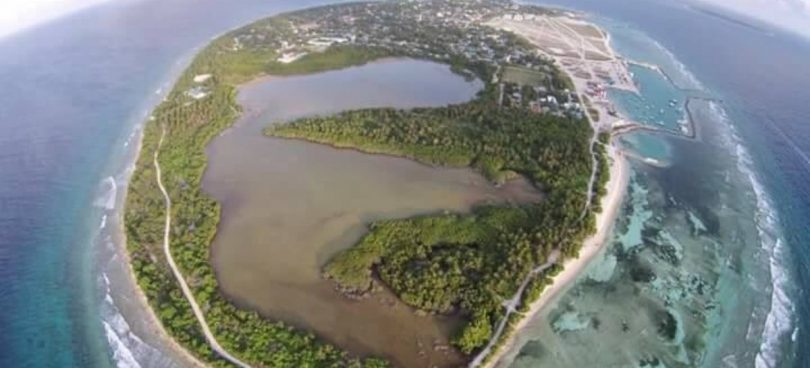Reclaiming the Kulhudhufushi mangrove to develop an airport on the northern island will cause lasting damage, an Environmental Impact Assessment for the US$11.4 million project has warned.
According to the EIA report by private consultant Dr Zahid Hameed, the “considerable negative impacts on the environment” include the permanent loss of habitat for flora and fauna, loss of terrestrial vegetation and deforestation, and the effect on marine life due to sedimentation.
“The wetland area surrounding the Kulhi acts as a natural catchment for flood mitigation. If proper drainage is not established, the area will experience flood impacts,” warned the report, which was submitted Monday to the Environment Protection Agency.
The report advised that socio-economic benefits may not outweigh the negative impacts because an airport exists on the nearby island of Hanimadhoo.
The government’s plans to begin dredging the environmentally sensitive wetland area on the northern end of the island in November sparked an outcry from islanders and environmentalists. Developing an airport on Kulhudhufushi, the main population hub in the northern atolls, was a campaign pledge of President Abdulla Yameen.
During a community consultation meeting with Dr Zahid in April, a majority of attendees favoured building the airport in a different location. But the report noted that the eastern side of the island was dismissed due to space limitations.
The government also rejected a nearby island as an alternative site and “a decision has been made to develop an airport by reclaiming Kulhudhuffushi Kulhi area”.
The consultant identified measures for mitigating the negative impacts such as the “creation of similar environment in another location”, the use of sediment screens and bund walls to minimise sedimentation, and replanting mature trees and coconut palms in a different area.
According to the report, the Regional Airports department has committed to undertaking the mitigation measures, carrying out environmental monitoring, and proposing a floodwater drainage system.
Environmental groups stress that the mangrove is home to endangered species and serves as a natural defence system by collecting and draining rainwater. Local women also gather coconut husk from the dense mangrove forest for weaving coir rope.
While the project is “undesirable from a purely environmental perspective”, the report suggested that the impact can be offset to an extent from an “obligation to better protect and preserve a similar environment in the region with a strict conservation program”.
The report concluded: “There is political will to proceed with the project along with the backing and need of a vocal majority in the island. As this is a project that has long been delayed resulting in significant community issues, it does not seem the project will be delayed any further.”
Mangroves cannot be replaced. Seawalls & other hard engineering projects cannot protect an island as a #mangrove does #kulhudhuffushikulhi pic.twitter.com/3BLp2Y4k9a
— mvciviced (@mvciviced) October 23, 2017
“Reclamation of wetlands disrupts the natural drainage system & creates more areas prone 2 flooding” – #kulhudhuffushi RiskAssessment 2013 pic.twitter.com/fhtAftW8RH
— Nasheeth Thoha (@itsnasheeth) October 23, 2017
The #kulhudhuffushikulhi is a natural defence to reduce the risk of flooding & has significant ecologicial, social and economical value pic.twitter.com/unY9HkVZvL
— Nasheeth Thoha (@itsnasheeth) October 23, 2017
Kulhudhuffushi #mangroves harbours 8 species listed in @IUCNRedList
Destroying it 4 an airport need to stop.@AJEnglish @nytimes @guardian pic.twitter.com/mBhiA98IgJ— Abdulla Adam (@Abdulla_Adam) October 22, 2017
Wetlands are vital sites for migratory birds # Maldives should become a party to #BonnConvention #RamsarConvention #WorldMigratoryBirdDay pic.twitter.com/2Ha0vKQAPM
— Bluepeace (@bluepeacemv) May 11, 2017
Aiport VS #kulhudhuffushikulhi
Let’s look into the facts and see what’s a better choice. #savekulhudhuffushikulhi pic.twitter.com/sXmfIF3Eou— Adam Isham (@adamisham) October 23, 2017
Why we need to protect #KulhudhuffushiKulhi #savekulhudhuffushikulhi
Pls stop the idea and decision of building an airport on it pic.twitter.com/BXcxb2fLoL— Adam Isham (@adamisham) October 22, 2017
Why is @EU_Maldives funding #consevation of South #Mangroves & letting @EnvGovMv and @EPAMaldives destroy Northern mangroves?#End pic.twitter.com/Etq70x2lnD
— Abdulla Adam (@Abdulla_Adam) October 23, 2017
— Safa Sharyf ?❔ (@safasharyf) October 22, 2017
Hw previous reclamation of wetlands in #Kulhudhuffushi worsened the flood mitigation capacity. #SaveKulhudhuffushiKulhi @EnvGovMv pic.twitter.com/McELFlN1ox
— Abdulla Adam (@Abdulla_Adam) October 23, 2017
Apparently the EIA will propose 2 create an artificial mangrove after destroying this natural system. What even? Artfcl beach 2 mangroves? pic.twitter.com/mvPq3Zh70O
— Abdulla Adam (@Abdulla_Adam) October 22, 2017
How can we say goodbye to this beautiful and peaceful place? #KulhudhuffushiKulhi pic.twitter.com/aZoolQW9VS
— naxim ian haxn ?? (@naximian) October 23, 2017
Save my mother land and it’s treasured beautiful mangrove! ? #KulhudhuffushiKulhi #SaveTheNorth#AirportIsComing#NotCoolYameen
— Drumwaru (@mnwar_ab) October 23, 2017
Full details are available from the link below:







